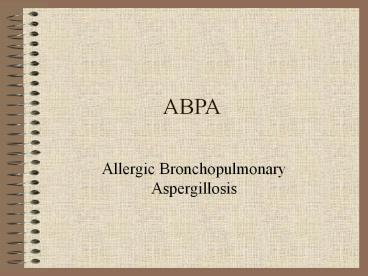ABPA - PowerPoint PPT Presentation
Title:
ABPA
Description:
ABPA Allergic Bronchopulmonary Aspergillosis Case B.C. - chronology 1983-Age 36, hx asthma. Persisting cough, mucous, sweats led to consultation and evaluation ... – PowerPoint PPT presentation
Number of Views:78
Avg rating:3.0/5.0
Title: ABPA
1
ABPA
- Allergic Bronchopulmonary Aspergillosis
2
Case B.C. - chronology
- 1983-Age 36, hx asthma. Persisting cough, mucous,
sweats led to consultation and evaluation - CXR-LLL infiltrate w/ cavitation and RUL cavity
- TEC 112 (on Prednisone)
- ESR 30 50
- Fungal CF and Immunodiffusion neg.
3
1983
- Bronchoscopy BxFibrosis and inflammatory
debris. A large number of inflammatory cells
are eosinophils and macrophages - Open lung biopsy rec. by Dr. Ed Goodman Chronic
bronchitis and bronchiolitis with acute
bronchopneumonia-etiology not demonstrated.
Specifically no vasculitis, no granuloma, no
mucoid impaction, and neg. AFB and Fungal stains.
4
1983
- Negative AFB cultures from sputum, bronchoscopy,
and OLBx. - Aspergillus species grew from sputum,
bronchoscopy, and OLBx - No specific diagnosis made, no specific Rx given
on Vanceril, TheoDur, and Ventolin
5
Various Years
- 1988 IgG, IgM, IgA, and Alpha-1 antitrypsin
negative - 1990 TEC 400
- 1991 Opinion from Dr. John Weissler at UTSWMS No
information or letter received - 1994 TEC 400
- 1995 Evaluation by Dr. Gary Gross Ragweed,
molds, and animal dander. Rx Intal and nasal
Atrovent. - 1998 Hospitaliztion for pneumonia
- 1999 Outpatient pneumonia
6
1999
- Opinion from Dr. Robert Sugarman, immunologist,
for recurring pneumonias - Diff Dx ABPA, ciliary dyskinesis, ASA
hypersensitivity, Cystic Fibrosis - IgE 1810, RAST IgE and IgG for Aspergillus
fumigatus elevated. - ABPA unifying diagnosis
7
More of the saga
- 2000 episode of pleurisy
- 2001 Sputum grew Mycobacterium avium complexRx
EMB, RMP, Biaxin - 2001 - Right back/flank pain H. zoster
8
2003
- 4/03 CXR worsened
- 5/03 CT Bronchiectasis, Adenopathy, and
pancreatic lesion - 5/03 Sputum grew Candida AFB negative
- 6/03 PET scan negative
- 7/03 Bronchoscopy for Bx and Lavage.
Bxchronic inflammation with eosinophilia.
Culture grew Aspergillus terreus. AFB negative.
Spirometry FVC 85,FEV1 70,FEF25-75 34 - Bone Density osteopenia
9
2003 contd
- 7/03 Rx Prednisone 80-40-20, Sporanox 100 mg
BID, Advair 500/50 BID - 9/03 FEV1 up to 2.1liters, Less cough,
subjectively improved, TEC 100, HRT added by GYN,
CXR/CT remarkably improved. Prednisone reduced
to 20 QOD - 12/03 TEC 200, IgE 739. Prednisone reduced to
15 QOD, Advair to 250 due to hoarseness, and
Sporanox continued
10
ABPA
- Complex hypersensitivity reaction in patients
with asthma that occurs when bronchi become
colonized by Aspergillus - Repeated episodes of bronchial obstruction,
inflammation, and mucoid impaction can lead to
Bronchiectasis, Fibrosis, and respiratory
compromise
11
ABPA Pathology
- Mucoid impaction of bronchi, eosinophilic
pneumonia, bronchocentric granulomatosis - Asthma
- Septated hyphae with dichotomous branching may be
seen in mucous, but do not invade the mucosa. - Culture in 2/3 of patients
12
ABPA Physiology
- No relationship between intensity of airborne
exposure and rates of sensitization - Healthy individuals can eliminate fungal spores
- Atopic individuals may form IgE and IgG
antibodies. Vigorous IgE and IgG immune
responses do not prevent this colonization.
Fungal proteolytic enzymes and mycotoxins are
released, in concert with Th2-mediated
eosinophilic inflammation, may lead to airway
damage and bronchiectasis
13
ABPA Clinical
- Asthma
- Bronchial obstruction
- Fever, malaise
- Expectoration of brownish mucous plugs
- Eosinophilia
- Hemoptysis
- Wheezing /-
14
ABPA Radiologic features
- Upper lobe infiltrates
- Atelectasis
- Tram lines
- Parallel lines
- Ring shadows
- Toothpaste shadows
- Gloved finger shadows
- Perihilar infiltrates may simulate adenopathy
- Cylindrical bronchiectasis
15
ABPA PFTs
- Airflow obstruction reduced FEV1
- Air trapping increased RV
- Positive BD response in ½
- Mixed obst. and rest. if bronchiectasis and
fibrosis present - Reduced DLCO if bronchiectasis present
16
ABPA Diagnosis
- Hx Asthma
- Skin test reactivity to Aspergillus
- Ppt. serum antibodies to A. fumigatus
- Serum IgE gt 1000 ng/ml
- Peripheral blood eosinophilia gt500/mm3
- Pulmonary infiltrates
- Central bronchiectasis
- Elevated IgE and IgG to A. fumigatus
17
Pulmonary Eosinophilia
- Drug and Toxin Induced
- Helminthic and Fungal Infection
- Acute Eosinophilic Pneumonia
- Chronic Eosinophilic Pneumonia
- Churg Strauss Syndrome
- Others-Hypereosinophilic Syndrome, Idiopathic
Lung diseases, neoplasms, non-helminthic
infections
18
ABPA vs. Asthma
- ABPA in 6 30 of asthmatics with skin test
reactivity to Aspergillus - Features of ABPA may be common in asthmatics
without ABPA - Positive skin test to Aspergillus in 20-30
- Positive serum ppt.to Aspergillus in 10
asthmatics and 10 of nonasthmatic chronic lung
disease patients - Recurrent Mucoid impaction and atelectasis
- Peripheral blood eosinophilia and elevated IgE
19
ABPA and Bronchiectasis
- Evaluate patients with Bronchiectasis for ABPA
unless prior necrotizing pneumonia - CT characteristics of bronchiectasis have failed
to differentiate ABPA from CF, ciliary
dysfunction, hypogammaglobulinemia, or idiopathic
causes.
20
ABPA Treatment
- Corticosteroids
- Inhaled steroids may help control symptoms of
asthma but do not have documented efficacy in
preventing acute episodes of ABPA - Itraconazole
21
ABPA Staging/Treatment
- I Acute flare Rx 1mg/kg prednisone for 14
days with 3 6 month taper - II Resolution of CXR with clinical improvement
with 35 reduction in IgE - III Recurrent exacerbations with 100 rise in
IgE. May be asymptomatic - IV Corticosteroid dependent asthma
- V Diffuse fibrotic lung disease due to repeated
episodes
22
Itraconazole
- Addition of itraconazole to corticosteroids in 55
patients for 16 weeks led to clinical response
(46 vs. 19 with placebo)-reduced steroid dose
50, 25 decrease in IgE, 25 improvement in FEV1
or exercise tolerance, or partial or complete
resolution of pulm. Infiltrates. - May augment activity of methylprednisolone
- May reduce specific aspergillus IgG
NEJM 2000342756-762.































